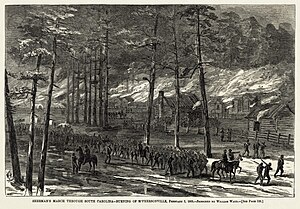Carolina Campaign
| Carolinas Campaign | |||||
|---|---|---|---|---|---|
| Part of the American Civil War | |||||
 Sherman in South Carolina: The burning of McPhersonville, 1865. (A sketch by William Waud from Harper's Weekly in 1865) |
|||||
|
|||||
| Belligerents | |||||
|
|
|
||||
| Commanders and leaders | |||||
| William T. Sherman | Joseph E. Johnston | ||||
| Units involved | |||||
| Army of Tennessee | |||||
The Carolinas Campaign was the final campaign in the Western Theater of the American Civil War. In January 1865, Union Maj. Gen. William Tecumseh Sherman advanced north from Savannah, Georgia, through the Carolinas, with the intention of linking up with Union forces in Virginia. The defeat of Confederate Gen. Joseph E. Johnston's army at the Battle of Bentonville in March, and its surrender in April, represented the loss of the final major army of the Confederacy.
After Sherman captured Savannah, the culmination of his march to the sea, he was ordered by Union Army general-in-chief Lt. Gen. Ulysses S. Grant to embark his army on ships to reinforce the Army of the Potomac and the Army of the James in Virginia, where Grant was bogged down in the Siege of Petersburg against Confederate General Robert E. Lee. Sherman had bigger things in mind. He predicted on January 5, 1865: "I do think that in the several grand epochs of this war, my name will have a prominent part." He persuaded Grant that he should march north through the Carolinas instead, destroying everything of military value along the way, similar to his march to the sea through Georgia. Sherman was particularly interested in targeting South Carolina, the first state to secede from the Union, for the effect it would have on Southern morale.
...
Wikipedia
